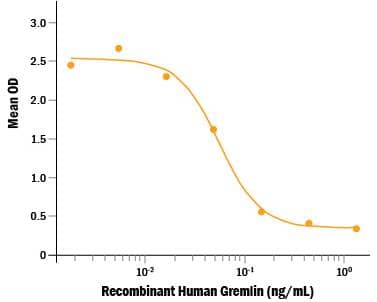Recombinant Human Gremlin Protein, CF
R&D Systems, part of Bio-Techne | Catalog # 5190-GR

Key Product Details
Source
Accession #
Structure / Form
Conjugate
Applications
Product Specifications
Source
Lys25-Asp184, with a C-terminal 10-His tag
Purity
Endotoxin Level
N-terminal Sequence Analysis
Predicted Molecular Mass
SDS-PAGE
Activity
The ED50 for this effect is 0.025-0.15 μg/mL in the presence of 30 ng/mL of Recombinant Human BMP‑4 (Catalog # 314-BP).
Reviewed Applications
Read 2 reviews rated 4.5 using 5190-GR in the following applications:
Scientific Data Images for Recombinant Human Gremlin Protein, CF
Recombinant Human Gremlin Protein Bioactivity
Recombinant Human Gremlin (Catalog # 5190-GR) inhibits BMP-4-induced alkaline phosphatase production in the MC3T3-E1 mouse preosteoblast cell line. The ED50 for this effect is 0.025-0.15 µg/mL in the presence of 30 ng/mL of Recombinant Human BMP-4 (Catalog # 314-BP).Recombinant Human Gremlin Protein SDS-PAGE
1 µg/lane of Recombinant Human Gremlin was resolved with SDS-PAGE under reducing (R) conditions and visualized by silver staining, showing major bands at 25‑30 kDa. Multiple bands in gel are due to variable glycosylation.Formulation, Preparation and Storage
5190-GR
| Formulation | Lyophilized from a 0.2 μm filtered solution in PBS and EDTA. |
| Reconstitution |
Reconstitute at 200 μg/mL in sterile PBS.
|
| Shipping | The product is shipped at ambient temperature. Upon receipt, store it immediately at the temperature recommended below. |
| Stability & Storage | Use a manual defrost freezer and avoid repeated freeze-thaw cycles.
|
Background: Gremlin
Gremlin, also known as Increased in High Glucose protein 2 (IHG-2) and Down-regulated in Mos-transformed cells protein (Drm), is a 28 kDa member of the Dan family of secreted glycoproteins (1-3). Human Gremlin is synthesized as a 184 amino acid (aa) precursor that contains a 24 aa signal sequence and a 160 aa mature region (SwissProt # O60565). The mature region contains one potential site for N-linked glycosylation (Asn 42), a cysteine-rich region, and a cysteine-knot motif (aa 94‑184) whose structure is shared by members of the TGF-beta superfamily (3). Post-translational modifications include glycosylation and phosphorylation (3). Gremlin exists in both secreted and membrane-associated forms (3). There are two isoforms for human Gremlin. Isoform 1 is the standard protein, and in isoform 2, there is a deletion of aa 39‑79. Human Gremlin shares 99% and 86% aa sequence identity with mouse and chick Gremlin, respectively. Northern blot analysis shows that Gremlin mRNA is highly expressed in the small intestine, fetal brain and colon, and weakly expressed in adult brain, ovary, prostate, pancreas and skeletal muscle (4). Gremlin functions as a bone morphogenetic protein (BMP) antagonist. It acts by binding to, and forming heterodimers with, BMP-2, BMP-4, and BMP-7, thus preventing them from interacting with their cell surface receptors (1). This mechanism is thought to be responsible for the pattern-inducing activity of Gremlin during embryonic development (5) and to play a role in human diseases, such as diabetic nephropathy (6). However, intracellular BMP-independent mechanisms of action (7) may mediate the ability of Gremlin to suppress transformation and tumorigenesis under certain experimental conditions (8-9). Gremlin also interacts with Slit proteins and acts as an inhibitor of monocyte chemotaxis (10). In addition, Gremlin has been found to be a proangiogenic factor expressed by endothelium (9).
References
- Hsu, D.R. et al. (1998) Mol. Cell 1:673.
- McMahon, R. et al. (2000) J. Biol. Chem. 275:9901.
- Wordinger, R.J. et al. (2008) Exp. Eye Res. 87:78.
- Topol, L.Z. et al. (2000) Cytogenet. Cell Genet. 89:79.
- Khokha, M.K. et al. (2003) Nat. Genet. 34:303.
- Lappin, D.W. et al. (2002) Nephrol. Dial. Transplant 17:65.
- Chen, B. et al. (2002) Biochem. Biophys. Res. Commun. 295:1135.
- Topol, L.Z. et al. (1997) Mol. Cell. Biol. 17:4801.
- Stabile, H. et al. (2007) Blood 109:1834.
- Chen, B. et al. (2004) J. Immunol. 173:5914.
Alternate Names
Gene Symbol
UniProt
Additional Gremlin Products
Product Documents for Recombinant Human Gremlin Protein, CF
Product Specific Notices for Recombinant Human Gremlin Protein, CF
For research use only

